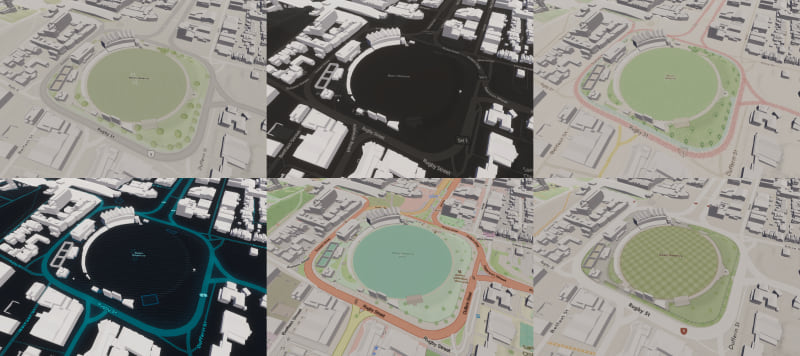The ArcGIS Maps SDK development team is pleased to announce version 1.1 of the ArcGIS Maps SDKs for Unity and Unreal Engine! Version 1.1 adds vector tile support, enhanced access to basemaps, and improvements to scene layer rendering and performance. Let’s dig into the details…
Vector tile layers
Vector tiles provide high quality display of complex cartography, and in general they deliver improved performance over image tile layers. In prior releases of the ArcGIS Maps SDKs for Game Engines you had to rely on image tile layers for your basemaps. Now you can use vector tile layers from a vector tile service or a local vector tile package, or vtpk. Esri provides a rich set of vector tile basemaps which you can use as is, with their default style, or with your own custom styles created with the ArcGIS Vector Tile Style Editor.
Basemap layer service
ArcGIS Platform’s basemap layer service provides access to a variety of global basemap layers which provide geographic context in a scene. As version 1.1 supports both vector and image tile layers, all basemaps are now available for use. The Basemap tab in the Map Creator UI (Unity) and Modes Panel UI (Unreal Engine) has also been enhanced to include a list of Esri curated basemaps for developers.

Scene layer improvements
We now support scene layers with Draco geometry compression. Draco compression optimizes the delivery of 3D geometries in a scene layer by compacting nodes which results in a smaller payload. This decreases the time to deliver complex 3D data to a client and results in improved performance. Draco compression was introduced with i3S 1.7, so we encourage use of scene layers published at version 1.7 or greater.
Physically Based Rendering (PBR) materials describe the visual properties of a surface and are used by scene layers to deliver 3D content that appears realistic under all lighting conditions. We improved support for PBR materials to more closely honor the roughness, reflections, colors, transparency, and textures published in a scene layer.
Other enhancements
- Set a global API key to use in every scene or level in a project
- Use the Quality Scaling Factor on the ArcGIS Camera component to control the quality of all ArcGIS layer content in a scene or level.
- ArcGIS Maps SDK for Unreal Engine now supports Unreal Engine 5.1
For more details on each of these enhancements, as well as a list of resolved and known issues, see the release notes for Unity and Unreal Engine.
Download and get started
To get your hands on version 1.1, go to the ArcGIS Developers web site, sign in, browse to the ArcGIS Maps SDK page of your choice, and download the SDK. If you’re new to developing with our Game Engine Maps SDKs, simply sign up for a free ArcGIS Developer account then head over to the Get Started page in the ArcGIS Maps SDK for Unity or ArcGIS Maps SDK for Unreal Engine documentation.



Article Discussion: